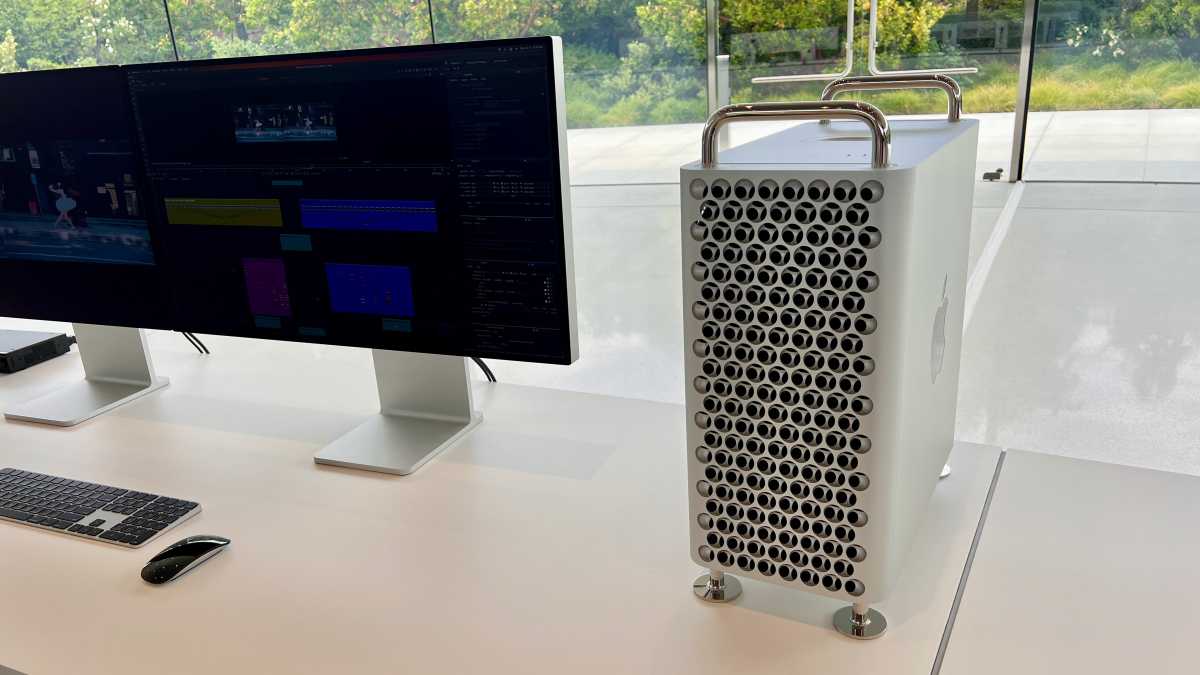
With the release of the Mac Studio in March, Apple also released its fastest processor ever. However, that chip, the M3 Ultra, is only available in the Mac Studio–it’s not available in the higher-end Mac Pro. Apple’s flagship Mac, once dubbed “the world’s fastest personal computer,” still runs the M2 Ultra chip that was released in 2022.
That leaves the Mac Pro as a glaring oddball in its Mac lineup. It’s an expensive tower computer starting at $6,999 with an out-of-date chip. Does this mean the tower Mac has come to an end? Perhaps, but there is a glimmer of hope, if you want to believe.
Mac Pro’s history in limbo
Apple has a history of leaving the Mac Pro in limbo. When the Mac Studio was first released in 2022, the Mac Pro didn’t get an update and eventually became the last Mac with Intel CPUs. At that time, it was still possible to get an Intel Mac Pro that was technically faster than the M1 Ultra Mac Studio, but you had to pay a premium for Xeon CPUs and graphics card upgrades that were clearly on the way out.
The Mac Pro’s Apple silicon update finally came in 2023 when it got an M2 Ultra chip alongside the Mac Studio. Apple didn’t change much about the Mac Pro other than its chip, though it took away the ability to add aftermarket RAM and graphics. The 2023 Mac Pro is essentially a machine for users who need PCIe expansion cards–a specialized market, but one that positions the Mac as a top-tier creative workstation.

Apple introduced the first M-series Mac Pro in 2023 at WWDC.
Foundry
But since the M2 Ultra offered the same performance in the tiny Mac Studio and the tower of the Mac Pro, the questions about the Mac Pro’s viability persisted. Its very existence doesn’t make sense, especially for a company that prides itself on maintaining profit margins and managing production costs. Apple doesn’t release data on individual units sold, but it seems hard to believe that the Mac Pro, which starts at a price tag that’s $3,000 more than the Mac Studio, sells in high enough quantity to justify its place in the lineup.
But the Mac Pro has come back from the dead before. The current design with Intel chips was released in 2019, six years after the ill-received cylindrical Mac Pro. That long gap was disrupted in 2017, when Apple announced that the Mac Pro would get the modular design it still uses today. So, a languishing Mac Pro isn’t new, and its history feeds into speculation about its viability.
Mac Studio in the spotlight
What’s different this time is the introduction of the Mac Studio in 2021. Its launch suggested that the Mac Pro was on the way out, and with updates in 2023 and 2025, Apple has established the Mac Studio as a smaller Mac Pro with the fastest M-series chip. In fact, if speed is your top priority, the fastest Mac you can buy isn’t even the Mac Pro right now—it’s M3 Ultra Mac Studio.
Granted, the Mac Pro is the only option for a Mac user who needs expansion slots, but at least with its prior iterations, you were guaranteed to get the fastest chip, too. With the launch of the M3 Ultra, expansion is the only justification to get the Mac Pro, making its specialized status even more specialized.
This isn’t the first time Apple targeted the higher-end workstation market with a small, compact computer with limited upgradability. The Mac Studio is something of a rebirth of the 2013 cylindrical Mac Pro. Both have compact, space-saving designs and the fastest chips. Both have a lot of ports for connecting devices. Both are workstations for demanding users but not the most demanding users.
Apple was quite proud of the 2013 Mac Pro; at its unveiling, Apple’s Phil Schiller famously quipped, “Can’t innovate anymore, my ass.” The Mac Studio is similarly innovative and its easy to assume it will take the place of the Mac Pro at some point. It doesn’t help that there aren’t any Mac Pro rumors that point to any specific specifications, new tech, design tweaks, or anything else. The only rumor to speak of is a mention that it might arrive later this year, but a tentative spot on the release schedule isn’t reassuring.
What the future holds
So if the Mac Studio is the workstation value model, Apple has an opportunity to reposition the Mac Pro instead of letting it fade away. I’ve always thought that this Mac in particular should be a showcase for that latest (if not cutting edge) tech. It should always have the fastest CPU, the beefiest GPU, the latest Thunderbolt, Wi-Fi, and Bluetooth iterations, and whatever else Apple can do (what the heck, put a C1 in it!). And it should be updated frequently regularly with whatever the latest thing is. It’s not a machine that just anyone can afford, but so what? Apple can afford to have a low-volume selling Mac that has the main purpose of flexing muscle. The fact that you can buy it is a bonus.
It’s also the only Mac made in the U.S. As announced back in 2019, the Mac Pro is manufactured in Austin, Texas, and includes “components designed, developed and manufactured by more than a dozen American companies for distribution to US customers.” With tariffs threatening to upend Apple’s pipeline, a U.S.-made computer could be a boon to Apple’s bargaining position.
As Macworld columnist Jason Snell recently hypothesized, Apple could also have bigger plans for its chips that would require the available cooling space within the Mac Pro. Reports have said that Apple is working on a server chip for online AI processing, and perhaps after Apple will unveil this chip alongside a reimagined Mac Pro. It might seem like a long shot, but the Mac Pro has been reborn so many times, a glimmer is all Mac Pro fans need to keep hope alive.






